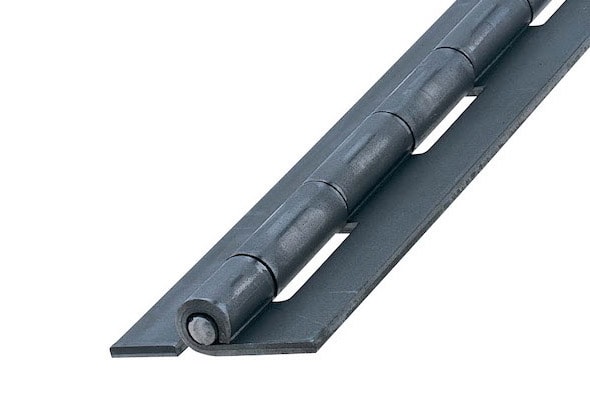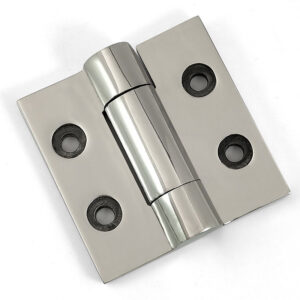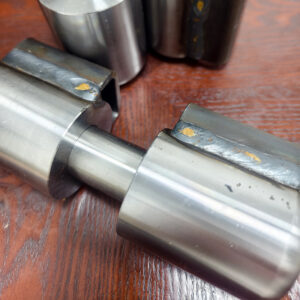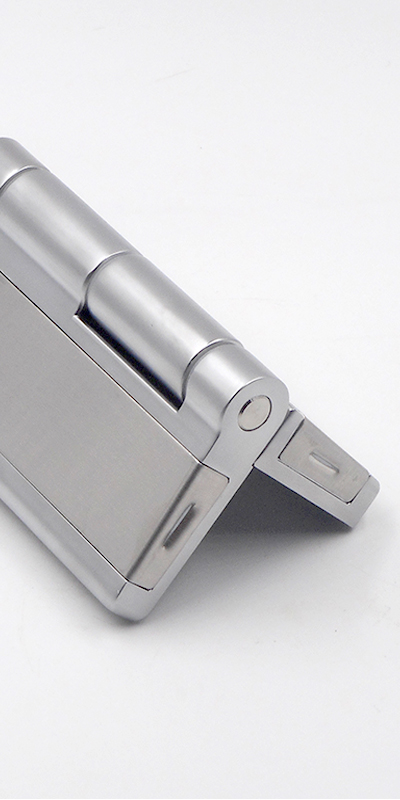Not all industrial hinges use bare metal finishes. To resist corrosion, many undergo galvanization, either electro-galvanizing or hot-dip galvanizing, creating a protective zinc layer.
Electro-galvanized hinges use electroplating to apply a thin, smooth zinc coating, while hot-dipped hinges are immersed in molten zinc for a thicker, more durable protective layer.
Both methods protect against rust, but their durability, cost, and surface finish vary significantly.
Introduction to Galvanized Hinges in Industry
Galvanized coatings protect hinges from corrosion, extending their operational life. This protection is essential in industrial equipment, storage enclosures, and outdoor machinery.
Galvanized coatings act as a corrosion barrier, ensuring hinges last longer in harsh industrial environments.

Galvanization is especially critical for outdoor industrial hinges, such as marine hinges, where exposure to saltwater or extreme weather accelerates corrosion. Industrial buyers select between electro-galvanized and hot-dipped finishes based on durability needs, operational environments, and cost considerations.
What Is Electro-Galvanization?
Electro-galvanization uses an electroplating process to apply zinc. Hinges are submerged in an electrolyte solution, and an electric current deposits zinc ions onto the surface.
Electro-galvanized coatings are typically 5–30 microns thick, smooth, and shiny, offering moderate protection at lower cost.
How Electro-Galvanization Works
The controlled process produces a uniform coating that improves appearance and provides basic corrosion resistance. For example, manufacturers often apply it to butt hinges used in electrical enclosures or machinery that operates indoors.
Industrial Applications
Electro-galvanized hinges are ideal for environments with minimal exposure to water and chemicals. They provide a balance of aesthetics and corrosion resistance, making them suitable for sheet metal fabrications and light-duty enclosures.
What Is Hot-Dip Galvanization?
Hot-dip galvanization immerses hinges in molten zinc heated to about 840°F. Once cooled, a thick zinc-iron alloy coating forms.
Hot-dip galvanizing creates a zinc layer 45–100 microns thick, offering superior corrosion resistance for heavy-duty applications.
Durability of Hot-Dip Coating
The hot-dip method forms a metallurgical bond between zinc and steel, creating a rugged layer resistant to abrasion and long-term corrosion. This makes it preferred for heavy duty hinges used in transportation, marine, and outdoor storage systems.
Applications in Harsh Environments
Hot-dip galvanized hinges are common in trailers, cold storage rooms, and marine equipment. Their thick, matte finish withstands constant moisture, abrasive conditions, and outdoor exposure, ensuring long service life with minimal maintenance.
Process Differences: Electroplating vs Hot Dipping
Electroplating uses an electrolytic bath and electrical current. Hot dipping uses full immersion in molten zinc.
Electroplating produces smooth surfaces quickly; hot-dip coating yields rougher but more durable protection.
Electro-galvanizing ensures precise, thin coatings, often chosen for components requiring a uniform aesthetic. Hot-dipping delivers superior outdoor corrosion resistance, essential for equipment like trailer door systems or industrial storage.
Coating Thickness and Durability
Electro-galvanized coatings measure 5–30 microns. Hot-dipped coatings range 45–100 microns.
Hot-dipped hinges last significantly longer in harsh environments due to thicker coatings.
Electro-galvanization suits light-duty indoor hinges, while hot-dip galvanization serves long-term outdoor industrial use. Buyers should evaluate environmental exposure, service life, and load-bearing requirements before choosing a finish.

Surface Finish and Appearance
Electro-galvanized finishes are bright and smooth, enhancing the product’s appearance. Hot-dipped finishes are dull and rough but highly functional.
Electro-galvanized coatings prioritize aesthetics; hot-dipped coatings prioritize protection.
The finish choice affects market positioning. Manufacturers seeking decorative appeal for exposed hinges may prefer electro-galvanization, while rugged industries prioritize hot-dip protection.
Cost and Efficiency Comparison
Electro-galvanizing is faster and cheaper due to shorter processing time and lower energy needs. Hot-dip galvanizing is more expensive but provides longer-lasting protection.
Electro-galvanized hinges cost less; hot-dipped hinges cost more but reduce long-term replacement expenses.
For mass production, electro-galvanization reduces upfront costs. For mission-critical machinery, hot-dip galvanization ensures fewer failures and replacements, often proving more cost-effective over time.
Performance in Outdoor vs Indoor Environments
Electro-galvanized hinges are suited for indoor applications with limited exposure to moisture. Hot-dipped hinges perform better outdoors in marine, agricultural, and transportation industries.
Hot-dipped coatings last decades outdoors; electro-galvanized coatings are limited to shorter-term indoor use.
Industrial buyers should align hinge selection with climate, operating cycles, and maintenance capabilities.
Electro-Galvanized vs Stainless Steel vs Zinc Plated
Electro-galvanized coatings offer moderate protection. Stainless steel provides superior corrosion resistance but at a higher cost. Zinc plating offers the least durability, with very thin coatings.
Stainless steel outperforms zinc coatings in extreme environments, but cost favors electro- and hot-dip galvanization for industrial hinges.
This hierarchy helps buyers compare costs and performance, particularly for demanding industries like test equipment and marine hardware.
Industry Use Cases and Selection Guidelines
Electro-galvanized hinges suit electrical cabinets, machinery enclosures, and decorative parts. Hot-dipped hinges serve outdoor trailers, marine structures, and storage facilities.
Buyers should match hinge finish to environmental exposure, lifespan expectations, and project budgets.
Industries such as cold storage, transportation, and marine rely heavily on galvanization choices. Selecting the right hinge finish directly impacts service life and maintenance costs.
Common Misconceptions Addressed
-
Does electro galvanized steel rust? Yes, eventually, but slower than bare steel.
-
Is electro-galvanized better than hot-dipped? It depends: indoors yes, outdoors no.
-
What is better than hot-dipped? Stainless steel, in extreme corrosion environments.
Conclusion
Electro-galvanized and hot-dip galvanized hinges both offer zinc protection but serve different needs. Choosing correctly ensures durability, efficiency, and cost-effectiveness in industrial applications.



